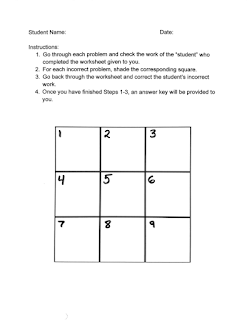Personal Learning Path #4
Background
I am working from the New York State Teacher Certification Examinations (NYSTCE) standards, Field 004: Mathematics. This week, we will be discussing a topic from Competency 0004 - Calculus. Within this Competency, I have chosen the following performance indicator: "applies techniques of differentiation and integration (e.g., product rule, chain rule, u-substitution)."
There are no NY State Common Core Learning Standards for Mathematics which align with my selected topic. Regardless, I am choosing to focus on the "power rule." This is a common differentiation technique used in all calculus courses.
My goal is to create an engaging activity for students to practice using the power rule.
For reference, here is the power rule:The Activity
An answer key is provided below (click on the images to see them in greater detail).
The teacher can grade this assignment in a number of ways, but my recommendation is to collect the 3x3 grid worksheets. That way the teacher can simply check to see if the pattern has been filled in correctly. It makes grading quite easy! The teacher could also grade on completion if that is their preference. They could also choose to grade both worksheets to see if the student has then arrived at the correct answer. Another option is that the teacher could simply present the filled-in grid in the front of the classroom to have students self-assess their own work. Then you could review the most troubling problems as a class. The options are endless.
The reference provided at the end of this post has many other practice problems which could be used to create a similar activity. It is a simple idea, so anyone reading can feel free to use this idea with their own practice problems or patterns.
Reflection
The goal of this post was to create an activity to practice working with the power rule. There are two things I like about this activity: (1) It is more creative than a typical math worksheet by incorporating the "pattern" sheet. It gives students an ounce of fun while also making it easier to grade for teachers. (2) I also like that the worksheet does not ask students to simply complete problems. It asks them to use their critical analysis skills by having them analyze student work. This is a valuable skill on its own, but it also prepares students to check their own work on future assignments and assessments.
This activity also has many potential modifications, since the idea is quite simple. The "grid" idea can be applied to nearly any math topic. All you'd have to do to incorporate this grid pattern idea into your lesson is to number the problems of your worksheet. The grid could be larger or smaller depending on the number of problems you'd like. The actual worksheet could also be modified in many ways. The worksheet does not need to ask students to analyze the work for correct or incorrect answers. It can have students complete or analyze the problems in any way as long as there is a binary yes-no answer in order for it to correspond to the grid.
References
- Power rule image: https://www.khanacademy.org/math/old-ap-calculus-ab/ab-derivative-rules/ab-diff-negative-fraction-powers/a/power-rule-review
- Practice problems worksheet: https://www.upliftparent.org/cms/lib01/TX01001293/Centricity/Domain/273/0%20PROBLEMS%20all.pdf








Foster, I like how you add a different element to typical worksheet completion here. By switching up how students will present their answers, you are potentially engaging a wider variety of students. I also think that having students spot errors helps them learn material on a deeper level. You could go even further by having students teach their peers where errors occur in different problems! Great work.
ReplyDelete